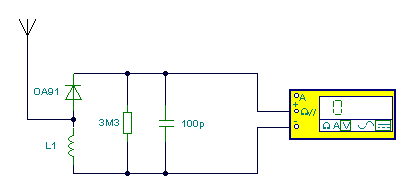ElectroMaster
Administrator
This Field Strength Meter is simple and also quite sensitive. It uses an ordinary digital voltmeter to measure signal strength. The VM should be set to the lowest dc volts range for maximum sensitivity. This is normally 200mV DC for most meters.
I have tried this at VHF and was quite pleased with the results. L1 was 7 turns on a quarter inch former with ferrite slug. This covered the UK FM band. A digital multimeter, as opposed to an analogue signal meter has several advantages in this circuit.
First, the impedance of a digital meter is very high, around 10M / volt on most meters. This does not shunt the tank circuit unduly. Second, as opposed to an analogue meter, very small differences in signal strength can be observed more easily on the digital meter. Thirdly, used with a digital meter, the FSM will have better linearity, responding well to both weak and stronger signals, a cheap analogue meter may not respond too well to very weak changes in signal strength.

I have tried this at VHF and was quite pleased with the results. L1 was 7 turns on a quarter inch former with ferrite slug. This covered the UK FM band. A digital multimeter, as opposed to an analogue signal meter has several advantages in this circuit.
First, the impedance of a digital meter is very high, around 10M / volt on most meters. This does not shunt the tank circuit unduly. Second, as opposed to an analogue meter, very small differences in signal strength can be observed more easily on the digital meter. Thirdly, used with a digital meter, the FSM will have better linearity, responding well to both weak and stronger signals, a cheap analogue meter may not respond too well to very weak changes in signal strength.

